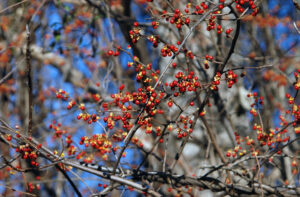
The berries of round leaf bittersweet (Celastrus orbiculatus) grow in clusters at each leaf axil. The highly invasive nature of this plant makes it unsuitable for use in fall decorations. / Photo Credit: Chris Evans, University of Illinois, Bugwood.org
By Erika Segerson-Mueller, Invasive Plant Program Specialist, Oshkosh Service Center;
Erika.Segersonmueller@wisconsin.gov or 715-492-0391
When temperatures begin to cool and back-to-school sales emerge, our thoughts turn to pumpkin spice, sweater weather and all things fall décor.
But as you gear up for spooky season this year, the Wisconsin Department of Natural Resources (DNR) reminds you to beware of using invasive plants in your decorations.
A quick Google or Pinterest search for fall décor ideas brings up a slew of orange-tinged images: pumpkins, leaves, pinecones and pretty fall foliage boasting small, red-orange berries. While you can safely cloak your home in most of these items, avoid the one with the red-orange berries, as it is likely the non-native woody vine, round leaf bittersweet (Celastrus orbiculatus), previously known as Oriental bittersweet. This plant has been used in holiday decorations for years because its beautiful fruiting branches are appealing to wreath makers and centerpiece arrangers. The brightly colored berries are equally appealing to birds, who eat the berries and spread the seeds to new locations.

American bittersweet (Celastrus scandens), a native plant, has similar berries clustered at the end of each branch and is a great alternative to use in fall wreaths and arrangements. / Photo Credit: Chris Evans, University of Illinois, Bugwood.org
A rapidly spreading perennial climbing vine, round leaf bittersweet forms dense stands and shades out other vegetation. It is often found invading forests and may damage trees by girdling trunks with its woody stem or weighing down their crowns, making them susceptible to wind or heavy snowfall damage.
Round leaf bittersweet is regulated under NR40, the Wisconsin rule that makes it illegal to possess, transport or transfer certain invasive species. Possession of restricted species, including round leaf bittersweet, is allowed under this rule. However, transfer is not permitted. Therefore, it is technically illegal to make wreaths for others as gifts or for sale, so please refrain from doing so.
American bittersweet is a native plant with similar-looking berries that is a great alternative to this aggressive invader. To tell the two apart, look closely at where the berries are growing on the branches of the plant. American bittersweet (Celastrus scandens) will have fewer, larger clusters of fruit (the eye-catching red berries) that are at the end of the branches. On invasive round leaf bittersweet, the berries are found clustered at each leaf axil (the angle between the upper side of a stem and a leaf or branch), so they will appear to be all along the branches rather than just at the ends.
You can find more information on how to control round leaf bittersweet in the UW-Extension fact sheet on bittersweet.
Remember that anything containing invasive round leaf bittersweet should not be composted, as this can result in further spread and infestation of the plant. Securely bag any invasive plants and send them to the landfill.
